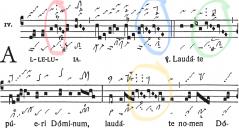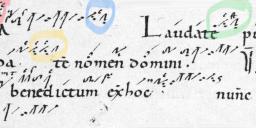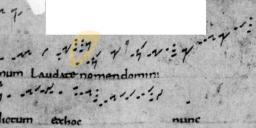Descending faster?
-
Is it proper interpretation to give descending notes (e.g., the little rhombuses in a climacus) less time value?
Are these little notes supposed to be tied/slurred? -
Rules for Interpretation p. xxiv answers both questions:5. Scandicus and climacus: these groups may be made up of three, four, five, or more notes. Care must be taken to have regularity in these groups, especially not to slide the descending diamond notes of the Climacus, which, notwithstanding their shape, have exactly the same value as the Virga at the beginning of the group.
-
Watch out for the Liquescent which have slightly smaller diamonds, that are difficult to see in some settings
-
This is the "official rhythm," yes, but during the heady last days of Ecclesia Dei the final group of people within the Church who might have felt themselves bound by these rules under any pain of obedience were disabused of that notion.
All of the above merely serves to bring me to the moment where, in good faith, I can legitimately ask the question I have always asked when confronted with Absolute Equalism --- If they are the same, why are they not written the same?
On the flip side, however, I am not a Proportionalist.
Over many years of conducting chant, I have lost (and likely gained) a lot of "notions." Along the way, I have developed a fairly consistent way of interacting with the shapes that seems to make for both good & satisfying music and good, natural, intelligible declamation of the text.
This sometimes requires extra direction from the outside not contained in the shapes themselves (hold this, release here...) but the earliest manuscripts seem themselves to have this exact kind of direction written into them, so I don't lose any sleep over doing so myself.
*shrug* Personally, I tend to take the descending lines a little quicker if it seems to respect the natural gravity of the phrase, and to hold back on them if it seems tempting to rush through them unmusically. -
I pretty much am of the same mindAll of the above merely serves to bring me to the moment where, in good faith, I can legitimately ask the question I have always asked when confronted with Absolute Equalism --- If they are the same, why are they not written the same?
On the flip side, however, I am not a Proportionalist.
Over many years of conducting chant, I have lost (and likely gained) a lot of "notions." Along the way, I have developed a fairly consistent way of interacting with the shapes that seems to make for both good & satisfying music and good, natural, intelligible declamation of the text.
This sometimes requires extra direction from the outside not contained in the shapes themselves (hold this, release here...) but the earliest manuscripts seem themselves to have this exact kind of direction written into them, so I don't lose any sleep over doing so myself.
*shrug* Personally, I tend to take the descending lines a little quicker if it seems to respect the natural gravity of the phrase, and to hold back on them if it seems tempting to rush through them unmusically. -
I agree with Nihil as well. My choir has a tendency to want to slow down for any excuse, so having them purposely speed up a bit there keeps them on pace.
-
In fact, that's from the preface to the Vatican edition, not the Solesmes Rules for Interpretation. The "semiologists" sometimes speed up on the climacus, even where it's written entirely long or long-short-long in the manuscripts. I don't understand it at all. As for "why are they not written the same?," well, they are in the modern notation editions. The virga represents a note that is relatively higher in pitch, not necessarily longer, especially in the St. Gall notation, yet the same figure may appear as three vertical puncta in Laon.
-
Here, several examples in today's alleluia:

red: long-short-short-long-long-long (5 beats) if you're following Laon, long-short-short-short-short-long (4 beats) if you're following the St. Gall Cantatorium
blue: long-long-long-grace-long-long (5 beats) for L, ssssll (4) for C
green: lssssll is a straightforward reading of both L and C, but see Chartres 47:
and Bamberg 6:
which suggest lsslgll instead - 5 beats either way
yellow: Ch and B make it clear that the correct rhythm is sslsslss (5) rather than 8 shorts
There's no reason to think the virga should be longer than the puncta in any of the seven instances.
It might be enlightening to explore how or if these examples relate to good, natural, intelligible declamation of the text.
 4B1E0818-1AC2-46E3-893B-13E974565220.jpeg1862 x 999 - 652K
4B1E0818-1AC2-46E3-893B-13E974565220.jpeg1862 x 999 - 652K
 7C308E8E-AC00-44AC-B7B8-64D3F460CCB3.jpeg1824 x 530 - 289K
7C308E8E-AC00-44AC-B7B8-64D3F460CCB3.jpeg1824 x 530 - 289K
 728BD6A1-BE18-419A-B83C-8CA885B282D5.jpeg1824 x 430 - 212K
728BD6A1-BE18-419A-B83C-8CA885B282D5.jpeg1824 x 430 - 212K -
I very much agree with NihilNominis, and I have nothing to add to Patrick's learned discussion, which shows that the three-note descending figure can come with a variety of different rhythmic profiles in the earliest manuscripts. As with what Patrick writes above, I was once told by someone who had sung a bunch with the group Sequentia that the figure always ends with two quick notes, which of course is not supported by study of the usual manuscripts.
I would like to contribute two interesting side points about later chant performance practice, though. First, in the fifteenth and sixteenth centuries, it seems that some people did choose to make the two diamond-shaped notes faster, reasoning that the square and diamond notes look like breves and semibreves of mensural notation. Gaffurius writes this: "These however are equal in pronunciation and rhythmic value, although some sing them twice as fast as the others, which we believe to be done not according to reason, but according to the whim of the singer." I'm taking that translation from Joshua Veltman's interesting 2004 dissertation, page 128. Anyway, there was not widespread agreement then as now, I imagine. Of course the condemnation of the practice means it was probably pretty widespread.
Second, latent in this question is an interesting and (as far as I know) unwritten feature of the Solesmes tradition, such as it is. The line "Care must be taken to have regularity in these groups, especially not to slide the descending diamond notes of the Climacus" quoted from the Vatican preface above has, in many places, been taken pretty seriously. I have been told by a conductor steeped in the Fontgombault/ICKSP style that one should slow down a little bit on every climacus, presumably as a counterweight to the tendency to rush or to read the two diamond-shaped notes as less significant or quicker. This tendency to slow down is probably much more pronounced when the climacus forms part of a thesis within a larger rhythm. Consider as an example the figure at "Coget omnes" in the Dies irae, which recurs several later times. It seems very nice to drag those six descending notes out just a little bit, while singing more or less according to the rhythmic signs in the Liber usualis.Thanked by 1FSSPmusic -
Here is the key work (edited for clarity) in Nihil's soliloquy:
musically
Surprising how many priests do not grok "musically," and how many choir directors cannot/do not apply that word to Chant singing. -
Dad29
I was going to say the exact same thing…
Musically
Welcome to the MusicaSacra Forum!
To participate in the discussions on Catholic church music, sign in or register as a forum member, The forum is a project of the Church Music Association of America.
Categories
- All Discussions21,096
- General Music Discussion8,211
- Job Openings197
- Management of Music Programs850
- Choral Matters532
- Church Documents and Rubrics524
- CMAA Notes301
- Events716
- For Newcomers: Read First26
- Sacred Polyphony546
- Hymnody872
- Gregorian Chant: General2,697
- ↳ Graduale Romanum and Liber Usualis368
- ↳ Graduale Simplex60
- ↳ Semiology63
- Vernacular Plainsong696
- Anglican Use and Anglican Chant68
- Organ, Other Instruments and Repertoire435
- New Composition/Works in Progress1,290
- Recordings230
- Music for Hispanic Ministry159
- Music Education: Children211
- Music Education: General222
- News Items245
- Positions Wanted2
- General Discussion: Catholicism739
- Amusements177
- General Discussion1,033
- Opinions117

